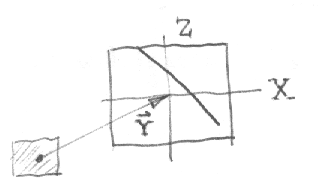Below we denote vectors with bold symbols.
If we don't worry about value of coefficient a, then we can pick up separate
units for screen and space. For example, x,z can be measured in pixels and
X,Y,Z,R measured in meters or steps.
1. Lens transformation (L) preserves lines.
a. for line in plane Y=const: kxX + kzZ = 0,
the image will be: k'xx + k'zz = 0:
 b. for line not in front plane:
R = cY + b =>
r = ac + abt,
where t = 1/Y.
2. Notably, because lens transformation of front panel is simply a dilation,
then angles and parallel lines in front plane are preserved.
3. Other parallel lines project to lines which cross at some point on the screen:
r = ac + ab1t --> ac and
r = ac + ab2t --> ac,
when Y --> oo
The common point roo=ac is called vanishing point.
b. for line not in front plane:
R = cY + b =>
r = ac + abt,
where t = 1/Y.
2. Notably, because lens transformation of front panel is simply a dilation,
then angles and parallel lines in front plane are preserved.
3. Other parallel lines project to lines which cross at some point on the screen:
r = ac + ab1t --> ac and
r = ac + ab2t --> ac,
when Y --> oo
The common point roo=ac is called vanishing point.
 4. Non-distortion of front planes, implies non-distortion of composition of lens
transformations. This simply means that if secondary observer sees the image
created by the first observer, then the secondary image is the same
as secondary observer saw the scene directly at certain distance and
conditions. More accurate:
R'
r'' = a''a' ------- .
Y''Y'
Effective dilation coefficient:
a''' = a''a'/Y''.
Effective focal distance:
f''' = f''f'/Y''.
Effective distance: Y''' = Y'.
4. Non-distortion of front planes, implies non-distortion of composition of lens
transformations. This simply means that if secondary observer sees the image
created by the first observer, then the secondary image is the same
as secondary observer saw the scene directly at certain distance and
conditions. More accurate:
R'
r'' = a''a' ------- .
Y''Y'
Effective dilation coefficient:
a''' = a''a'/Y''.
Effective focal distance:
f''' = f''f'/Y''.
Effective distance: Y''' = Y'.
 b. for line not in front plane:
R = cY + b =>
r = ac + abt,
where t = 1/Y.
2. Notably, because lens transformation of front panel is simply a dilation,
then angles and parallel lines in front plane are preserved.
3. Other parallel lines project to lines which cross at some point on the screen:
r = ac + ab1t --> ac and
r = ac + ab2t --> ac,
when Y --> oo
The common point roo=ac is called vanishing point.
b. for line not in front plane:
R = cY + b =>
r = ac + abt,
where t = 1/Y.
2. Notably, because lens transformation of front panel is simply a dilation,
then angles and parallel lines in front plane are preserved.
3. Other parallel lines project to lines which cross at some point on the screen:
r = ac + ab1t --> ac and
r = ac + ab2t --> ac,
when Y --> oo
The common point roo=ac is called vanishing point.
 4. Non-distortion of front planes, implies non-distortion of composition of lens
transformations. This simply means that if secondary observer sees the image
created by the first observer, then the secondary image is the same
as secondary observer saw the scene directly at certain distance and
conditions. More accurate:
R'
r'' = a''a' ------- .
Y''Y'
Effective dilation coefficient:
a''' = a''a'/Y''.
Effective focal distance:
f''' = f''f'/Y''.
Effective distance: Y''' = Y'.
4. Non-distortion of front planes, implies non-distortion of composition of lens
transformations. This simply means that if secondary observer sees the image
created by the first observer, then the secondary image is the same
as secondary observer saw the scene directly at certain distance and
conditions. More accurate:
R'
r'' = a''a' ------- .
Y''Y'
Effective dilation coefficient:
a''' = a''a'/Y''.
Effective focal distance:
f''' = f''f'/Y''.
Effective distance: Y''' = Y'.